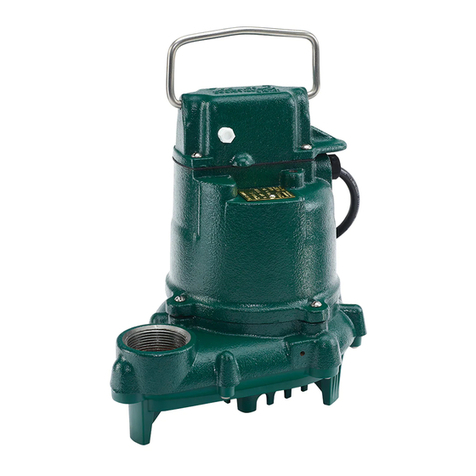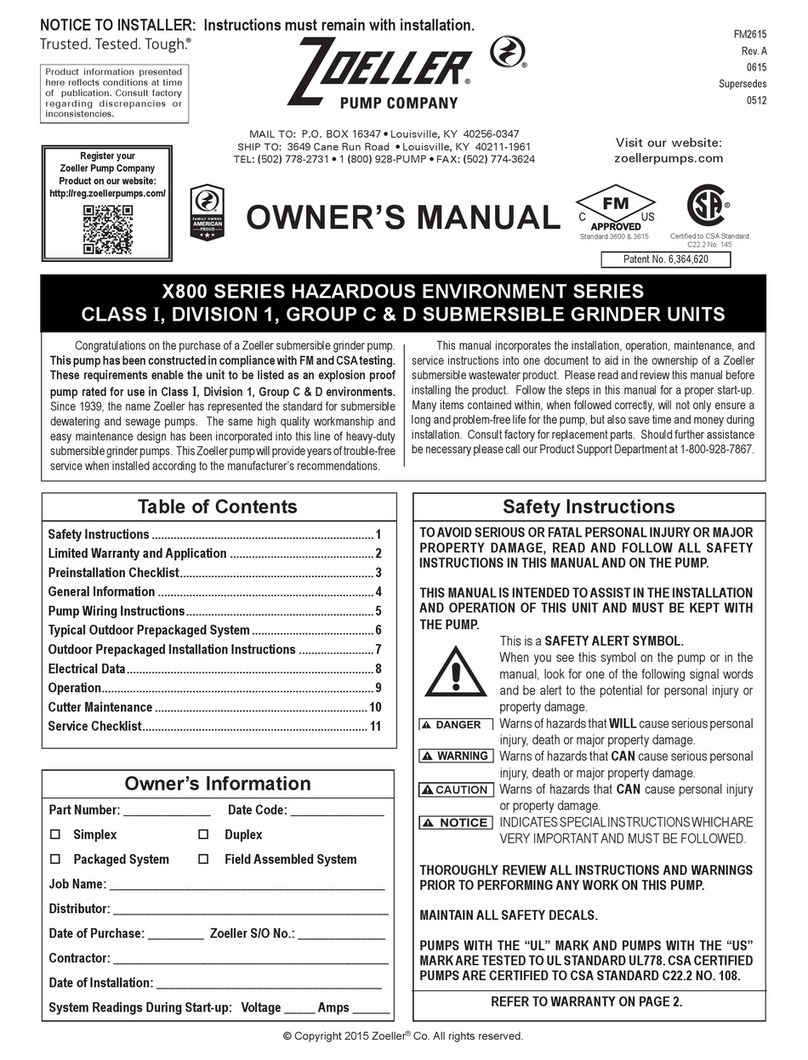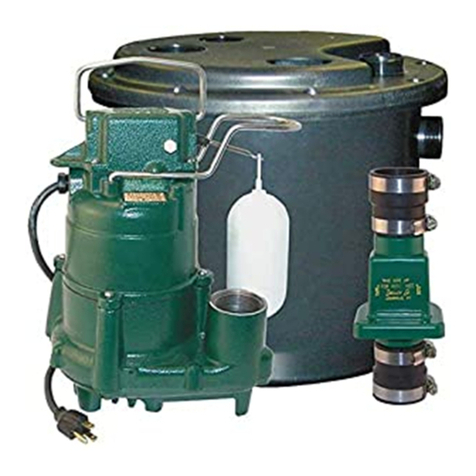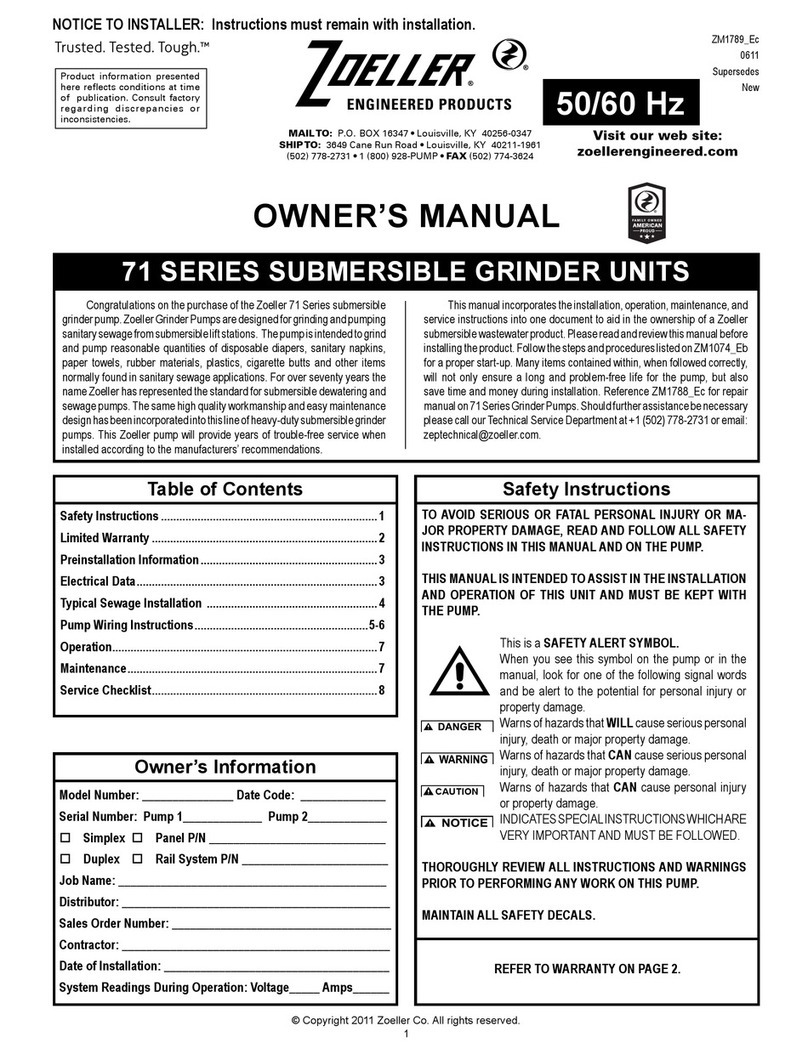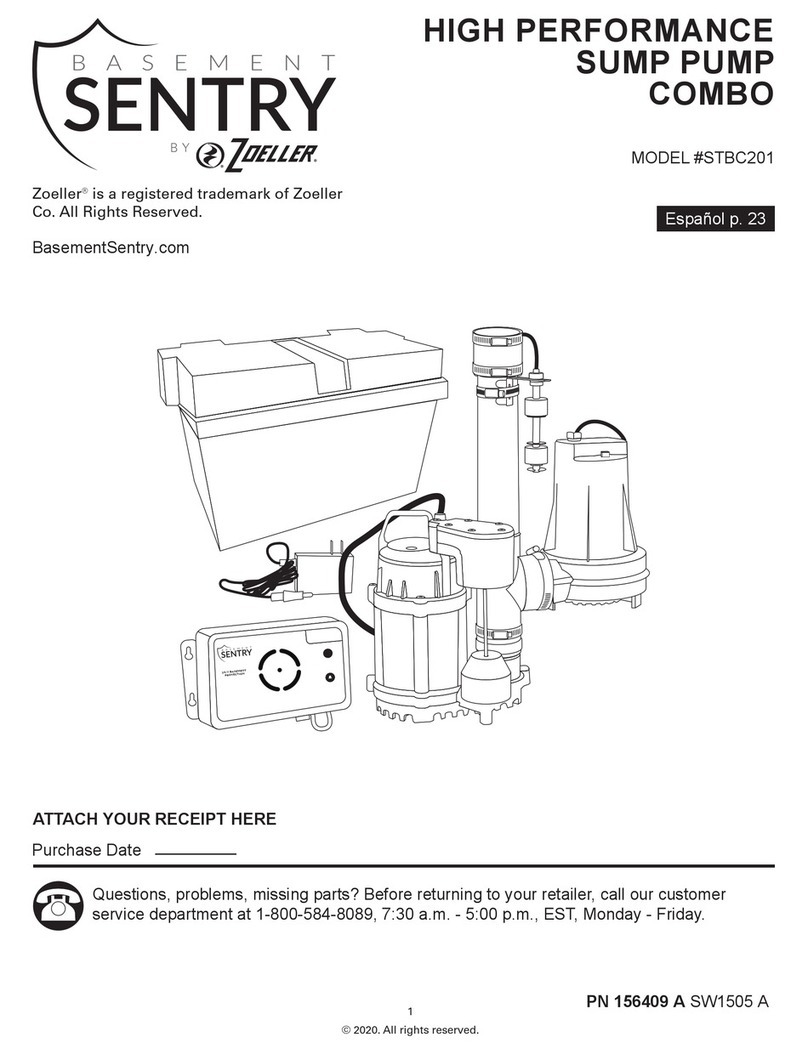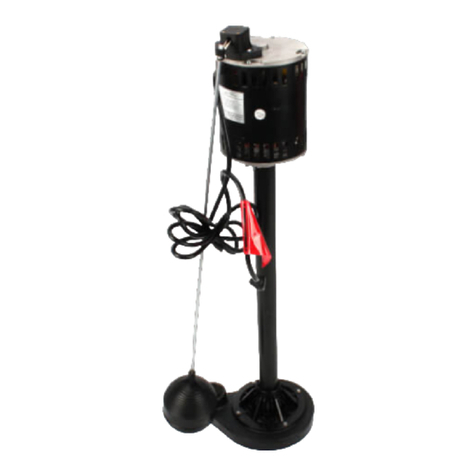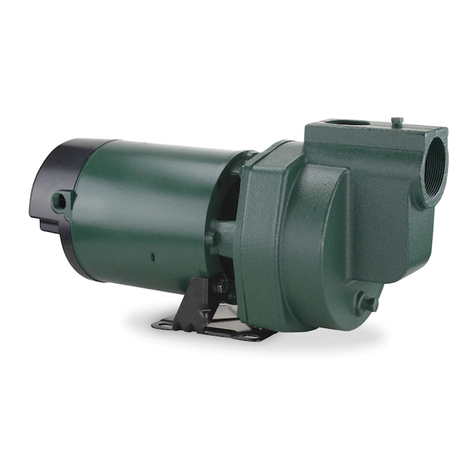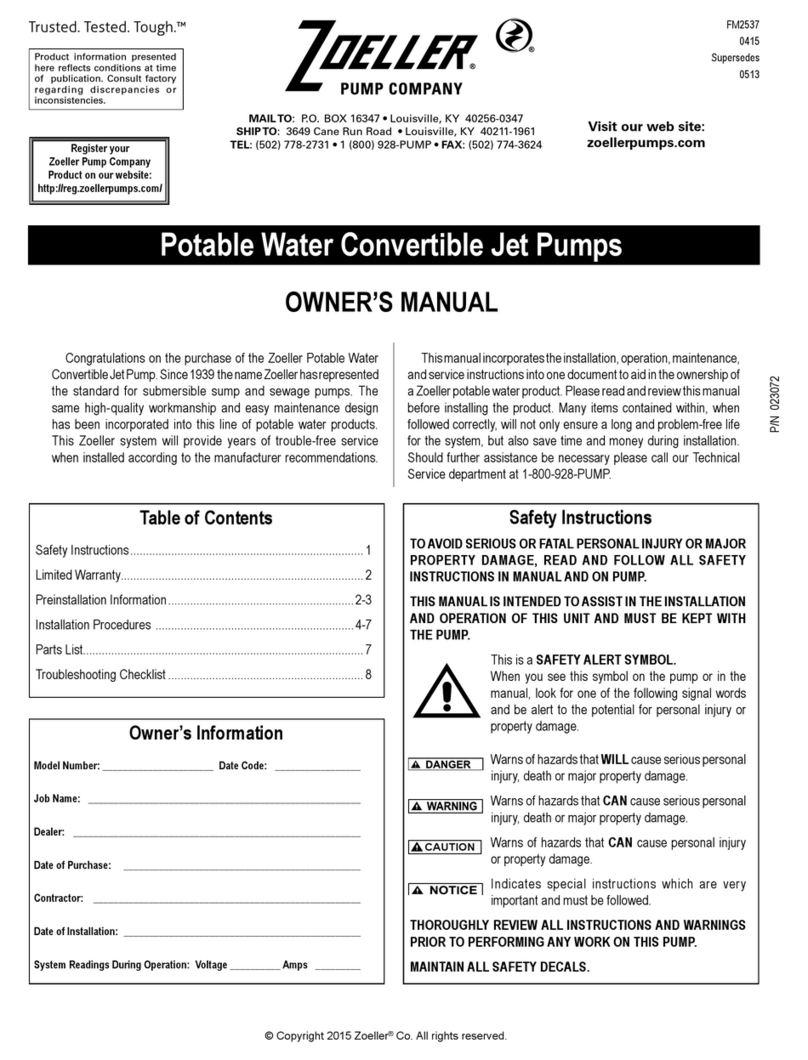
7
© Copyright 2015 Zoeller®Co. All rights reserved.
Operation
GENERAL
Zoeller pumps are lubricated and tested at the factory prior to shipment and require
minimum pre-start-up maintenance.
Maximum liquid temperature of a continuous operating pump liquid for standard
model pumps must not exceed 104°F (40°C). For longest service life all pumps should be
totally submerged on long pumping cycles. Maximum submerged depth is 50'.
These units are not designed to handle liquids other than water or sewage. If pump
is used in water contaminated with heavy, viscous, or abrasive materials, the war-
ranty will be voided.
NAMEPLATE DATA
The nameplate, located on the top of pump, indicates specic information about
the construction of the pump. The model number, date code, and serial number
information should be recorded on the front page in the “Owner’s Information”
section of this manual.
If the pump is repaired in th eld, its explosion
proof rating may be voided.
SHORT TERM STORAGE
If pump is to be stored, the following is advised:
• Store pump inside whenever possible or cover with some type of protective covering.
• Tape or seal in plastic bag the terminal ends of wire leads.
• Spray coat unpainted surfaces with rust inhibiting oil.
• The impeller should be rotated every six months in order to keep the seals
lubricated and not develop a permanent set.
If panel is to be stored, the following is advised:
• Store the panel inside whenever possible and leave in the shipping box.
• All openings shall be sealed.
• Store in an upright position.
• Do not stack anything on top of panel.
START-UP PROCEDURE
Before placing the equipment into operation the following should be checked:
• Correct pump rotation (3 Phase units only).
• Clean pit.
• Panel dry, securely installed and properly sealed.
• Floats positioned properly.
• Discharge valves open.
• 3/16” vent hole drilled in pipe between check valve and pump.
Once the above has been veried proceed with the following checks:
• Pump power cables properly connected to panel.
• Float cables properly connected in an intrinsically safe panel.
• Conduit connections to panel are properly sealed.
• Thermal overload adjustments made in the panel.
• After installing the pump into the containment area, with adequate submergence,
open the discharge valve fully. Start the unit using manual controls. If ow is
appreciably less than rated performance, pump may be air locked. To expel
trapped air, jog the unit several times, using the manual controls.
• Have a qualied electrician take voltage and current measurements on the black
wireofsingle phase orall three powerwiresof threephasewith the pumprunning.
Record these readings in the space provided in the “Owner’s Information”
section on page 1 of this manual for future reference.
After the preoperational functional test has been completed, system is ready for
operation. Zoeller requires completing a Start-up Report (ZM1074) whenever a
system is started for the rst time or after a system has had a signicant change
take place (i.e. pump replacement, overhaul, etc..). A copy of the Start-up Report
should remain with the system for future reference.
ADJUSTMENT PROCEDURE
Pumps: No adjustments are required other than assuring correct rotation.
Panels: The thermal overloads in the panel must be set to the F.L.A. rating on
the pump nameplate (or refer to pump data sheet).
Floats: Refer to the system drawing for desired location of each oat function.
Valves: Discharge valves should be placed in the fully open position. Systems
should not be operated for extended periods of time with the discharge
valves partially closed due to damaging the valve.
SHUTDOWN PROCEDURES
If a system is shutdown for more than six months, the following is recommended:
Pumps: If pit is to remain dry, then the pump can remain in the pit. With the
pump in the pit, it should be operated for ve minutes once every three
months. If the pit is to remain wet, the pump should be removed and
stored as noted above.
Panels: The panel should have all openings sealed to prevent moisture and dust
from entering the enclosure. Prior to restarting system, the panel should be
inspected for presence of moisture and any loose connections.
Valves: Consult the valve/actuator supplier for information concerning these
systems components.
Maintenance
Repair and service must be performed by a rm approved by
Zoeller Company. The rm must be certied to work on explosion proof motors if
motor housing, adapter or cord cap is repaired. Contact Zoeller Technical Service
Department regarding warranty issues.
Ifrepair tothemotorhousing, adapterorcordcap isdisassembled
or repaired by a rm not certied to work on explosion proof motors, the explosion
proof rating is void and the FM approval tag MUST BE REMOVED FROM THE
PUMP.SAFETY PROCEDURES.
For your protection, always disconnect pump and panel from its
power source before handling.
Never enter the basin until it has been properly vented and
tested. Any person entering a basin should be wearing a harness with safety rope
extending to the surface so that they can be pulled out in case of asphyxiation.
Sewage water gives off methane and hydrogen sulde gases, both of which can
be highly poisonous.
• Installation and checking of electrical circuits and hardware should be performed
by a qualied electrician.
• Pump is never to be lifted by power cord.
Unit must be ushed and disinfected, inside and out, prior to
servicing.
GENERAL SYSTEM INSPECTION
Before the system is placed into operation, a system Start-up Report should be
conducted by a qualied technician.
Wiring and grounding must be in accordance with the national
electrical code and all applicable local codes and ordinances.
LUBRICATION PROCEDURES
No lubrication is required.
• If pumps are to be stored for more than six months, refer to short term storage
procedure in the Operation section.
PREVENTIVE MAINTENANCE
Preventive maintenance is recommended to ensure a long service life from the
product. Provided is a suggested maintenance schedule.
Every month:
• Check for proper and unobstructed oat operation.
• Listen for proper check valve operation.
• Duplex Units - Check for even operating times. Uneven times indicate a
defective unit, oat switch or control.
• Inspect the panel for any presence of moisture in enclosure, loose connections, and
general component condition. check out location and condition of oat switches.
Every year:
• In addition to the monthly checks, the basin should be inspected and cleaned.
Any defective components should be replaced. Inspect and remove any sand,
debris, or mud present in the pump basin assembly.
Every two years:
• Inspect power cables for damage or wear. Replace immediately if damage
or wear is detected. Replace as required by an approved Service Station.
• Inspect impeller for damage or wear.
DOUBLE SEAL PUMPS
• Double seal pumps offer extra protection. During every inspection of the unit,
check the control panel seal failure for a warning. Whenever the seal leak is
activated, indicating that the lower seal has failed, the pump should be removed
and serviced in order to avoid damage to the motor.
